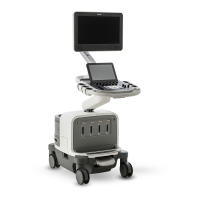
Do you have a question about the Philips epiq 7 and is the answer not in the manual?
| Power Requirements | 100-240 VAC, 50/60 Hz |
|---|---|
| Applications | Vascular |
| Transducer Ports | 4 active transducer ports |
| Imaging Modes | 2D, Color Doppler, Power Doppler, Tissue Doppler, Contrast Imaging |
| Advanced Features | Elastography, Anatomical Intelligence |
| Ports | Ethernet, USB, DVI |
| Dimensions | Varies by configuration |
| Weight | Varies by configuration |
| Connectivity | DICOM, Ethernet |
Covers general safety information applicable to the ultrasound system, transducers, and optional equipment.
Addresses shock hazards, proper grounding, power cord connection, and warnings related to electrical safety.
Outlines precautions related to the physical safety of the system, including wheels, inclines, and external devices.
Contains information on biological safety, prudent use of ultrasound, ALARA principle, and potential bioeffects.
Defines EMC, immunity, and emissions, and how they apply to the ultrasound system's operation.
Details controls located on the control panel, touch screen, and keyboard for system operation.
Describes data security features, logging on/off, and password management for patient data protection.
Explains how to use measurement tools, perform calculations, and analyze image data.
Provides guidance on selecting the correct transducer for optimal image quality and system compatibility.
Provides guidelines for ensuring patient safety when using intraoperative transducers.
Discusses common misuse areas and recommendations to prevent transducer damage.
Provides guidelines for ensuring patient safety during transesophageal echocardiography studies.
Discusses common problems and how to avoid them when using TEE transducers.
Covers electrical safety standards and precautions for TEE transducers.
Addresses leakage current hazards and compliance with IEC 60601-1 for TEE transducers.
Details the procedure for verifying biopsy guide alignment before each use.
Guides users through the steps of performing a biopsy procedure with proper alignment.
Lists warnings and cautions for using disinfectants and cleaning solutions with transducers.
Provides general cleaning instructions for all transducers, cables, and connectors.
Explains methods for disinfecting transducers using immersion or wipe techniques.
Details procedures for cleaning and maintaining the ultrasound system and its peripherals.
Provides a table of common symptoms and corrective actions for system issues.
Outlines classification, electromechanical safety standards met, and compliance with international standards.